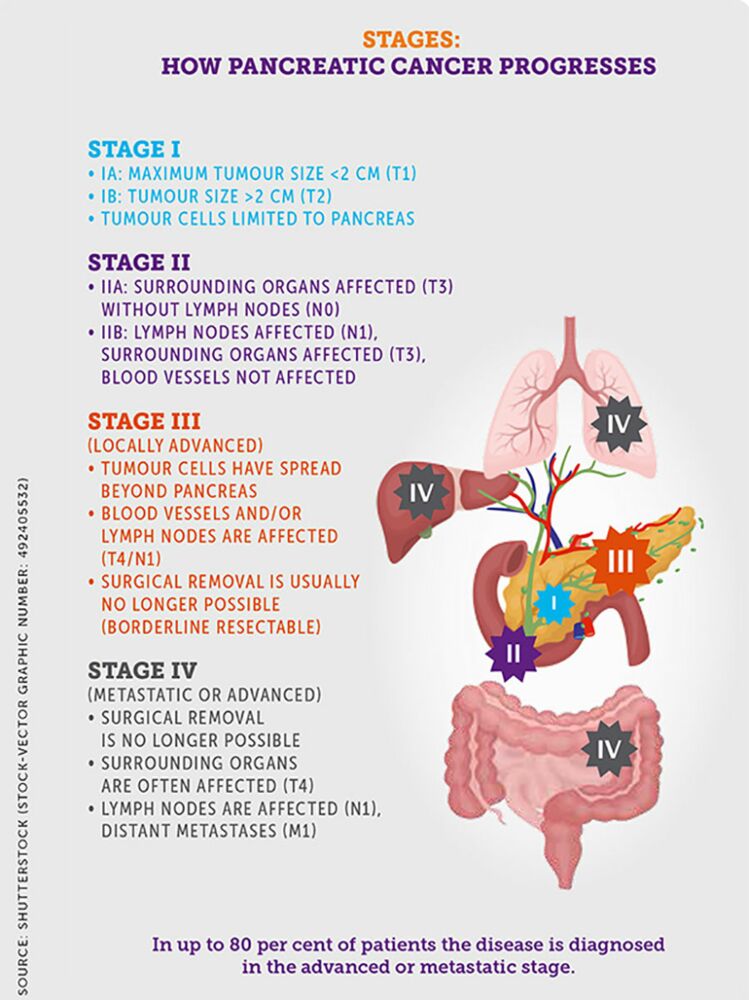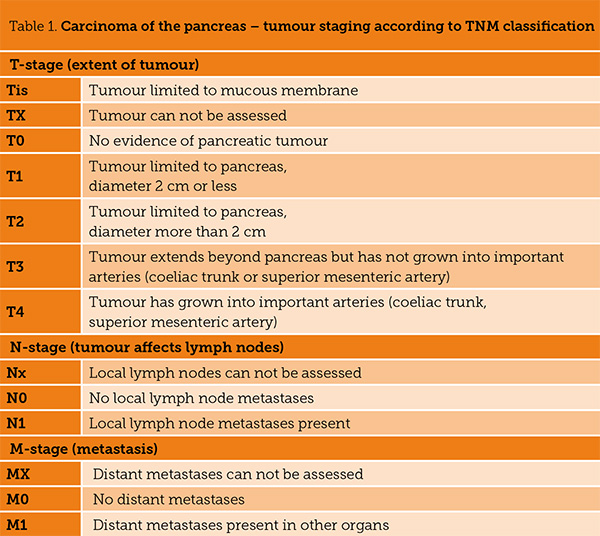TNM Classification of Malignant Tumours
The TNM classification is a uniform, standardised description to assess and evaluate tumour illnesses.The medical practitioner can use it to get a rapid idea of the extent of a tumour illness, in order to plan an appropriate therapy. Apart from that, the exchange of information between the doctors and clinics is made considerably simpler and treatment results and survey data can be better compared. The application of therapy recommendations from the medical guidelines is also simplified.
The relative TNM classification can be found in the doctors’ letters and patient’s file. The three letters T, N and M refer to
- T = size and proliferation of the tumour,
- N = (=node) neighbouring lymph nodes affected by cancer cells,
- M = Distant, respectively organ metastases,
whereby the figures after the letters enable a more precise specification. The following table referring to the pancreas carcinoma shows that.
Explanations to the following table:
Tis = Tumour in situ. This is an early form of cancer which has not yet affected neighbouring tissue.
The term T0 (no tumour visible) which is not mentioned above, is used, for example, after a successful treatment, when the primary tumour is not visible anymore.
The term “X” means that no information is available, while the term “0” means that no evidence is available. The term “MX” is meanwhile no longer used.
The “N” term is usually more precisely specified, for example after an operation. N1 (3/12) means that 3 of 12 existing lymph nodes were affected by cancer.
Lower-case letters inserted before the TNM classification indicate at which examination this result was established. The meaning of the letters is as follows:
- „c“ diagnosis through a clinical examination,
- „p“ diagnosis through a pathological examination,
- „u“ diagnosis through an ultrasound examination,
- „y“ a condition following a therapy ( e.g. when a radiotherapy or chemotherapy precedes an operation)
- „r“ the diagnosis of a relapse (recrudescence).
For example, ypT1N0M0 would mean that only a small tumour was found during an operation following a chemotherapy, the lymph nodes were not affected and also no distant metastases was found. The clinical and the post-operative or pathological examinations complement each other, whereby the pathological classification becomes more dependable.
The information content of the TNM classification can be increased through additional details, for which different capital letters and numbers stand. They are as follows:
- „L“ = Lymph channels not affected by cancer cells = L0 affected = L1,
- „V“ = Invasion of veins with cancer cells; no invasion = V0 invaded cells = V1, V2,
- „Pn“ = perineural invasion (affected nerve tissue); not affected = Pn0 and affected = Pn1.
We would like to point out that the TNM classification differentiates between lymph nodes (letter N) and lymph channels (letter L), in order to avoid any danger of confusion.
The tumour status after the operation can be established using the “R” classification. “R0” = no tumour, “R1” means microscopic tumour residue; “R2” visible tumour residue.
The grading system (letter G) identifies the malignancy of the tumours in 4 steps: 1 to 4. G1 would be normal tissue, well differentiated and G4 undifferentiated and badly developed.
The TNM classification and grading is not meaningful for some types of tumours (e.g. brain tumours, skin cancer). And the Gleason score is used for prostate carcinoma.
Next to the TNM classification, doctors also use the grade of allocation of the different stadiums according to UICC. The TNM classification is also the basis for the international allocation of different stages of a tumour illness according to UICC. Stage I is the lowest stage and Stage IV the most advanced stage of the spread of the tumours. This allocation of stages can be read below in the table:
Source table 1 and 2: according to Prof. Seufferlein and Dr. Ettrich






